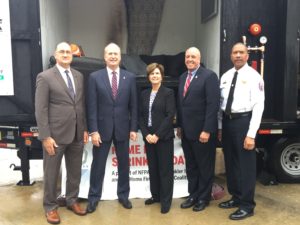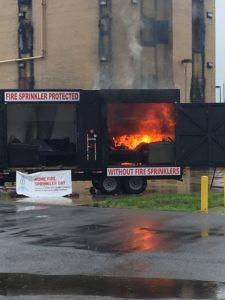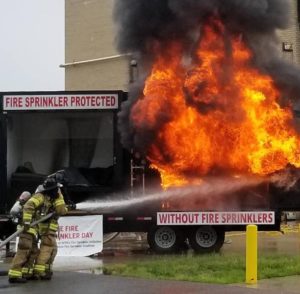More than 50 fire departments in 25 states and Canadian provinces held events last weekend to kick off the first ever Home Fire Sprinkler Day. The Home Fire Sprinkler Coalition (HFSC) and the National Fire Protection Association (NFPA) Fire Sprinkler Initiative organized the event to raise awareness of the life-saving benefits of home fire sprinklers and to counter the myths that interfere with their acceptance.
As local educational events took place across both countries, the two nonprofit organizations teamed up to kick off the day of action, and joined with the Maryland Office of the State Fire Marshal to conduct a fire and sprinkler demonstration at the Maryland Fire and Rescue Institute. Guest speakers included U.S. Fire Administrator Chief Keith Bryant, Maryland State Fire Marshal Brian Geraci, NFPA President Jim Pauley and the Prince George’s County Fire Chief Benjamin Barksdale. HFSC President and NFPA VP of Outreach and Advocacy Lorraine Carli emceed the event and narrated the demonstration for attendees. The event was live-streamed on social media channels with more than 3,500 viewers tuning in.

Speakers included (left to right) U.S. Fire Administrator Chief Keith Bryant, NFPA President Jim Pauley, HFSC President and NFPA VP of Outreach and Advocacy Lorraine Carli, Maryland State Fire Marshal Brian Geraci, and Prince George’s County Fire Chief Benjamin Barksdale.
Carli recognized the speakers for their leadership and commitment to reverse the home fire problem and to advance home fire sprinkler technology as a method to protect residents and firefighters. “Homes should be the place where people feel safe; yet in reality, it is where people have the greatest risk of injury or death from fire,” Carli said.
Chief Bryant talked about the USFA’s, “Fire is Everyone’s Fight,” initiative and how it unites the fire service, educators, builders, code officials, elected officials and everyone who plays a role in keeping our country safe from fire. Referring to the USFA’s website, Bryant said the administration monitors and shares home fire fatality data to increase awareness.
“To date, there have been more than 1,000 fatalities in residential structures in 2018, with close to 800 of those deaths in homes, Bryant said. “Increased installation of home fire sprinklers can play a role in bringing those numbers down.”
Chief Geraci said he was proud that Maryland is one of two states that require fire sprinkler installation in all new home construction. He referenced the Prince George’s County Report that was developed in partnership with HFSC to review the county’s 15-year experience with a fire sprinkler ordinance. Geraci said that 101 people died in home fires without sprinklers. There were 245 sprinkler activations with 446 residents present in the protected structures during the time of activation, with no deaths. He added that every year in Maryland, there are 100 people saved by fire sprinklers.
Pauley noted NFPA’s pride as one of the founding members of HFSC (along with the American Fire Sprinkler Association and the National Fire Sprinkler Association) and of its support of residential fire sprinkler legislative issues through NFPA’s Fire Sprinkler Initiative. He said the initiative has worked to develop 30 active state coalitions, many of which held Home Fire Sprinkler Day events in their regions.
“If you have a home fire, you are more likely to die today compared to 40 years ago because today’s home environments create fires that burn hotter and faster, placing occupants and responding firefighters in more dangerous situations,” Pauley said.
He also lamented the powerful sprinkler opponents who have convinced uninformed legislators and other decision-makers that home fire sprinkler requirements are not necessary. “Jurisdictions that allow new homes to be built without sprinklers allow substandard housing,” he said.
Chief Barksdale also referred to the Prince George’s County report and said it is proof that fire sprinklers protect residents and firefighters from injury and death. He said it is time to update the data and the report now that the county has 25 years of experience with the home fire sprinkler requirement. HFSC will work with the chief to promote the findings of the updated report.

The room on the left had little damage after the sprinkler activated 45 seconds after the fire started. Flashover occurred at just over three minutes after the fire was started in the room without a fire sprinkler.
Carli narrated the live side-by-side burn demonstration. It started with a fire lit in the room protected by sprinklers. Both rooms had identical, newly purchased living room furniture and smoke alarms. The smoke alarm activated at 17 seconds. The fire quickly spread, activating the sprinkler at 45 seconds. Carli reminded viewers that the typical fire department response time is 9 to 10 minutes. With sprinklers, a fire is controlled or extinguished while the fire is still small.
Next, a fire was started in the room without fire sprinklers. The smoke alarm sounded at 14 seconds. Carli pointed out how thick the smoke was from the burning furniture – a toxic and deadly mix. Flashover occurred at just over three minutes.
“Flashover is when everything in the room ignites. Once that happens, no one can survive,” Carli said.
As the firefighters approached the fire to extinguish it with their high-pressure hose, she pointed out the difference between the two rooms. She explained how it illustrates how dangerous a home fire is for responding firefighters considering what they are exposed to from heat and smoke.
The entire event can be viewed by visiting HFSC’s Facebook page, video section: https://www.facebook.com/HFSCorg/videos/1933497156724024/

